Eight students will be presenting the summer work at the Ocean Sciences Meeting in March 2022!
Sophia Caradine-Taber, St. Mary's College
Class Year:
2016Mentor:
Jacqueline Grebmeier, Ph.D.Project Title:
Ecosystem Changes in the Benthos: Length-Weight Measurements of Four Dominant Bivalve Species in the Northern Bering Sea from 2012 to 2015
Abstract:
Temporal and geographical trends in the sizes of members of the four dominant bivalve species (Nuculana radiata, Nuculana pernula, Macoma calcarea, and Ennucula tenuis) from in the northern Bering Sea in the St. Lawrence Island Polynya (SLIP) from 2012-2015 were studied. Clams were collected annually in July 2012-2015, and length and weight measurements were made on each individual clam collected. There was a significant decline in dominant bivalve length and weight over the 2012-2015 time period, and a significant replacement of the dominant species N. radiata by the dominant species N. pernula. In 2012, clam biomass was significantly higher in the northernmost stations (SLIP4 and SLIP4) than in the more southern stations (SLIP stations 1-3), but in 2015 clam biomass was more evenly distributed across the five stations. These changes in clam size and species composition over time may reflect population responses to ecosystem changes and food web re-structuring in the northern Bering Sea, particularly within the context of climate change. This length-weight dataset from 2012-2015 for dominant bivalves fills a gap in a larger dataset for benthic biomass which exists for the last 25 years in the SLIP.
Blog Posts:
See Sophie's posts to Fellowship Experiences, Maryland Sea Grant's blog written by and about fellows and their research.
"Exploring Climate Change in the Arctic Aboard an Icebreaker"
"Sea Ice, Sea Cucumbers, Sea Stars: My Summer Research off Alaska"
Location:
Chesapeake Biological LaboratoryPresentations:
Caradine-Taber, S.*, J. Grebmeier, L. Cooper, and C. Goethel. 2017. Ecosystem changes in the benthos: length-weight measurements of four dominant bivalve species in the northern Bering Sea from 2012 to 2015 . ASLO Aquatic Sciences Meeting, Honolulu, Hawaii .



